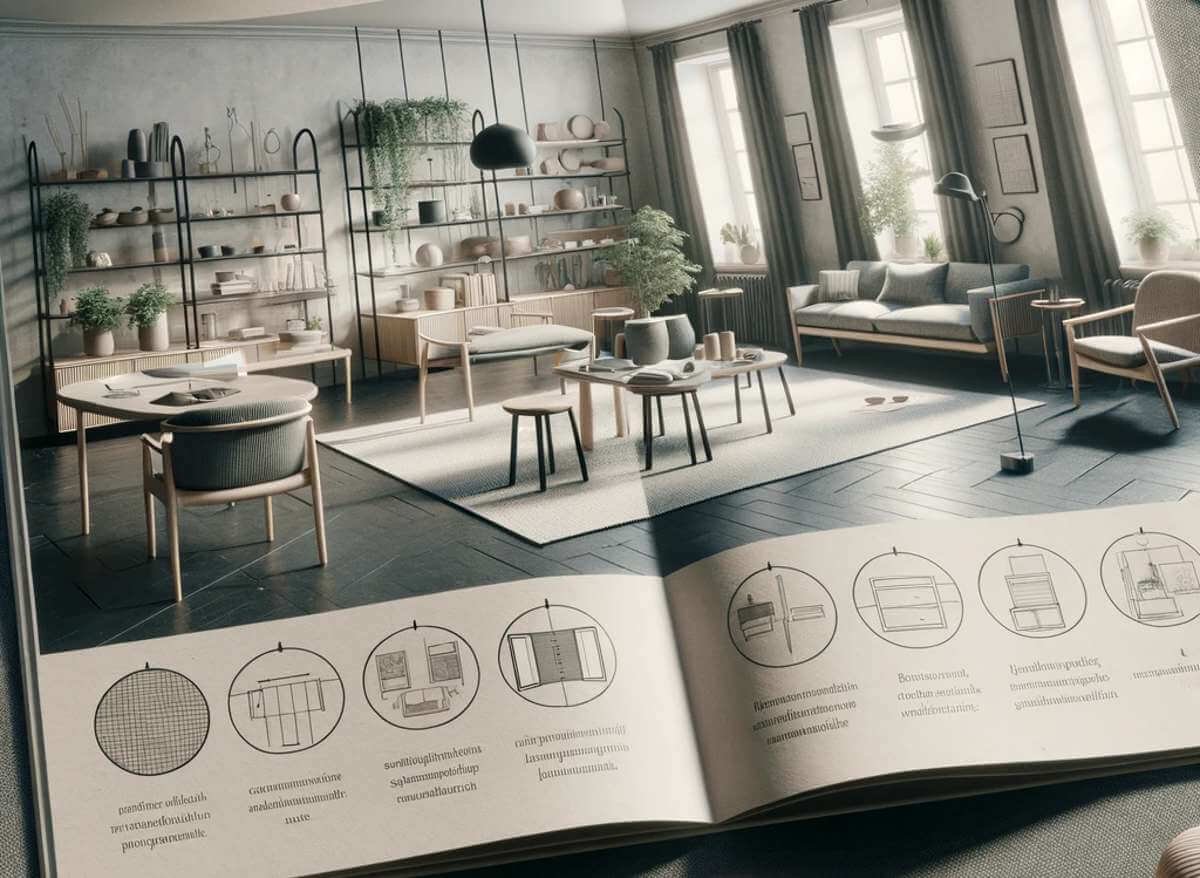Nestled in the Northern parts of Europe, the Nordic countries – Norway, Sweden, Denmark, Finland, and Iceland – are renowned for their breathtaking natural landscapes and a design aesthetic that is as serene as it is sophisticated. Nordic interior design, while diverse across these nations, shares a common thread of minimalism, functionality, and a deep connection with nature. As a Norwegian designer, I have experienced firsthand the harmony and tranquility these design principles bring to living spaces. This article explores the captivating elements of Nordic interior design, and how they come together to create environments that are not just visually appealing but soulfully nurturing.
Table of Contents
The Essence of Nordic Interior Design
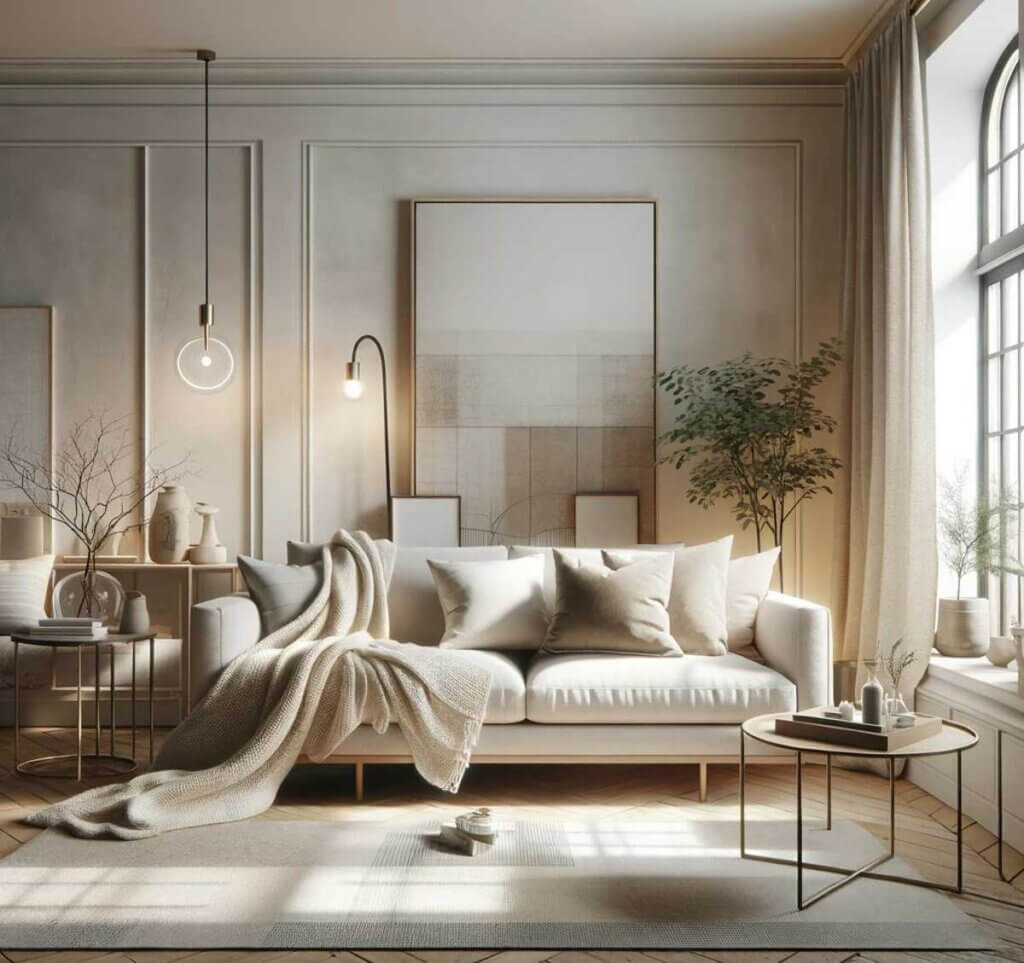
At the core of Nordic interior design is an ethos that transcends mere visual appeal; it is a philosophy of living harmoniously within one’s environment. This philosophy is deeply rooted in the geographical and cultural landscapes of the Nordic region. The long, dark winters and the brief, luminous summers have profoundly shaped our approach to design, leading to spaces that are not just functional and simple, but also deeply soulful and comforting.
A Symphony of Light and Space
In the Nordic design language, light is not just an aspect of design; it is its soul. We use light to counter the darkness of our winters, turning our homes into sanctuaries of warmth and brightness. The design maximizes natural light through large windows, often left undressed or with minimal treatments, to let in every precious ray of sunshine. During the darker months, the interplay of candles and well-designed lighting fixtures creates a soft, intimate atmosphere that is both uplifting and soothing.
Minimalism with Meaning
The clean lines and uncluttered spaces in Nordic design are not mere trends but reflections of a cultural inclination towards thoughtfulness and intention. Every element in a Nordic space has a purpose, a reason for being. This minimalism is not about austerity, but about finding beauty and serenity in simplicity. It is about creating environments that are calm, orderly, and imbued with a sense of balance and tranquility.
The Palette of Nature
Our color choices in Nordic design are whispers, not shouts. We draw our hues from the landscapes that surround us – the greys of stormy seas, the whites of snow-clad fjords, the soft greens of mossy forests, and the blues of twilight skies. This muted palette acts as a canvas, allowing the natural beauty of materials like wood, stone, and wool to take center stage. It also creates a backdrop that soothes the mind and spirit, evoking a sense of restfulness and ease.
Lagom – The Art of Balance
‘Lagom’, a Swedish term, encapsulates the Nordic pursuit of balance and moderation. It is about finding the ‘just right’ in everything – from the amount of light in a room to the number of furnishings. This concept extends beyond aesthetics to the very way we live our lives – seeking a harmony between work and rest, community and solitude, tradition and innovation.
The essence of Nordic design, as seen through the eyes of a Nordic artist, is much more than a style. It is a reflection of our history, our landscape, and our values. It is a design ethos that seeks to create spaces that are not just physically comfortable but also emotionally nurturing. In the heart of Nordic design lies a profound understanding of what it means to create a home – a place that is not just where we live but where we find peace, balance, and joy.
Natural Materials and Earthy Tones: A Tribute to Nordic Landscapes
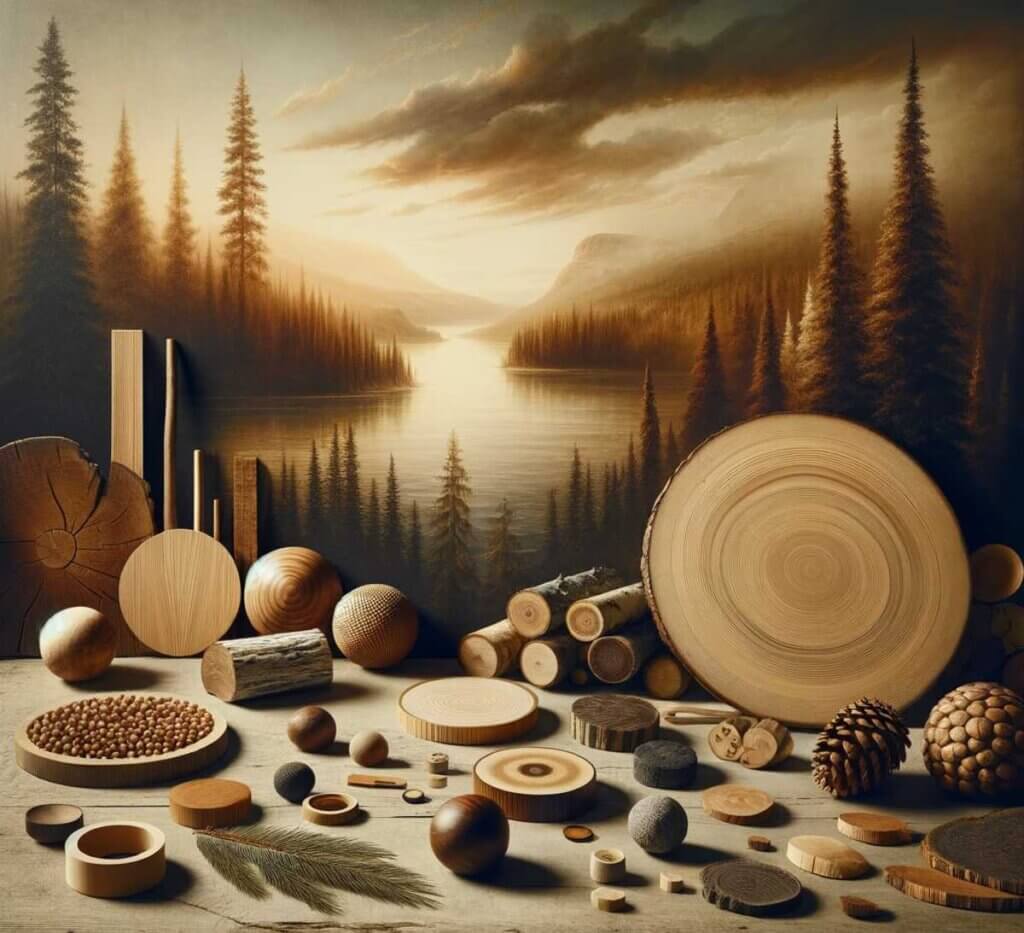
In the realm of Nordic design, the use of natural materials is not just a choice but a tribute to the vast and varied landscapes of the North. The deep forests, rugged coastlines, and expansive skies are echoed in the textures and tones found within our homes. Wood, in its myriad forms, is the heart of this material palette. Pine and oak, with their warm, golden hues, birch with its light, airy feel, and ash with its robust and resilient character, are more than just building materials. They are storytellers, each grain and knot narrating tales of Nordic wilderness.
The tactile warmth of these woods is complemented by other elements drawn directly from nature. Wool, with its cozy and comforting texture, speaks of the rolling hills and the sheep that graze upon them. Cotton, crisp and fresh, mirrors the clarity of the Nordic air. Leather, aged and supple, carries the resilience and strength of the wild.
This reverence for natural materials extends to the color palette of Nordic design. Here, the hues are a reflection of the outdoor world – the soft greys of morning mists over the fjords, the pure whites of winter snows, the deep greens of pine forests, and the tranquil blues of the northern seas. These colors don’t overpower; instead, they create a canvas that allows the natural beauty of the materials to shine through.
The use of these earthy tones and textures does more than just create aesthetic appeal. It creates a connection – a bridge between the indoors and the natural world outside. It’s a reminder of the beauty that lies beyond our windows and an invitation to bring that beauty into our everyday lives.
In every choice of material and color, there is a sense of belonging – to a land, a culture, and a way of life that values the beauty, simplicity, and imperfection of the natural world. This approach to design is a celebration, a way to honor and connect with the landscapes that have shaped us, and to create spaces that are not just beautiful, but also deeply rooted in the essence of the Nordic soul.
Functionality and Sustainability
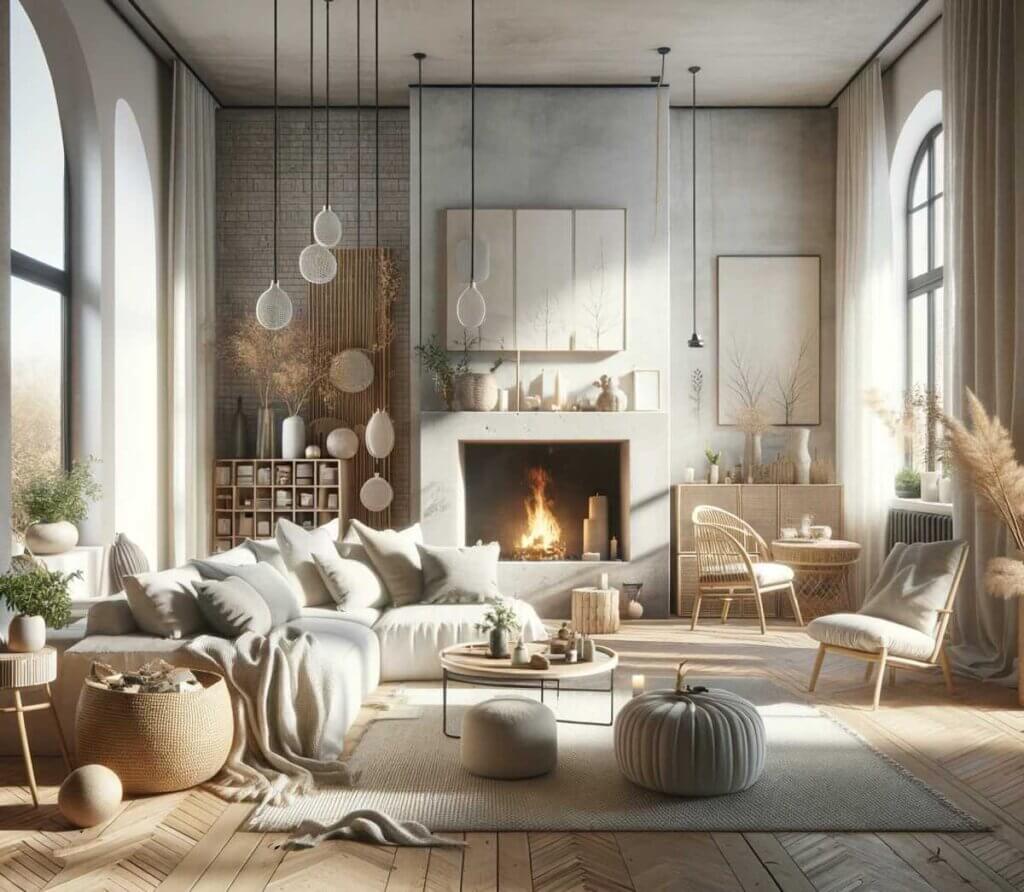
A key aspect of Nordic design is its focus on functionality. Every piece of furniture or decor is purposeful, contributing to a space that is both practical and aesthetically pleasing. There is also a growing emphasis on sustainability, reflecting the Nordic countries’ commitment to environmental protection. This translates into the use of eco-friendly materials and a philosophy of buying fewer, but higher quality, items that endure the test of time.
Functionality: The Cornerstone of Nordic Design
Purpose in Every Piece
In the world of Nordic design, functionality isn’t just a feature; it’s a philosophy. Every item, from the sleek lines of a chair to the subtle curves of a vase, is imbued with purpose. This mindful approach to design ensures that every element within a space is not just decorative but serves a practical role. It’s about creating environments that are liveable and adaptable, catering to the needs of daily life while maintaining an aesthetic of effortless elegance.
Streamlined for Simplicity
The functional nature of Nordic design can be seen in the streamlined forms and intelligent use of space. Storage solutions are often ingenious, seamlessly integrated into living areas without clutter or obstruction. Furniture is designed to be versatile, often serving multiple purposes or easily adjustable to suit different uses. This approach to design creates spaces that are uncluttered and open, promoting a sense of calm and order.
Sustainability: Embracing Environmental Responsibility
Eco-Friendly Materials
Sustainability is a growing focus in Nordic design, mirroring the deep respect for nature that is a hallmark of Scandinavian culture. This manifests in the careful selection of materials that are not only durable but also environmentally friendly. Recycled materials, sustainably sourced wood, non-toxic paints, and natural fibers are increasingly becoming the materials of choice. This shift reflects a commitment to reducing environmental impact and fostering a healthier, more sustainable lifestyle.
Longevity and Quality
There’s a timeless quality to Nordic design, a deliberate move away from the transient nature of trends. The emphasis is on creating pieces that are classic, enduring, and of high quality. This philosophy encourages a culture of ‘buying less but better’, where the focus is on acquiring items that will last for years, if not generations. It’s a sustainable approach that challenges the throwaway culture, reducing waste and promoting a more thoughtful consumption of resources.
A Harmonious Cycle
This fusion of functionality and sustainability in Nordic design creates a harmonious cycle. Functional design ensures that spaces and objects are used to their fullest potential, reducing the need for excessive possessions. Meanwhile, sustainable practices ensure that these designs are gentle on the planet, contributing to a healthier environment and a more mindful way of living. Together, these principles form the backbone of Nordic design, a reflection of a culture that values practicality, beauty, and environmental stewardship in equal measure.
Lighting: Illuminating Nordic Spaces
Given the limited natural light for a significant part of the year, lighting is crucial in Nordic interiors. It is used strategically to create warmth and a sense of wellbeing. Soft, diffused lighting, combined with stylish lamps and candles, adds to the cozy, inviting atmosphere – a concept referred as ‘hygge‘.
Mastering the Glow
In the Nordic world, where daylight is a cherished but often fleeting commodity, lighting transcends its functional role, becoming the very soul of interior design. It’s about more than just illuminating a room; it’s about creating moods, evoking emotions, and crafting atmospheres. The strategic use of lighting, from the placement of lamps to the choice of bulbs, is key to transforming spaces into havens of warmth and wellbeing.
The Art of Soft Illumination
Nordic lighting design focuses on soft, diffused light that gently envelops a space. This approach avoids harsh contrasts and shadows, creating an environment that is soothing to the eyes and calming to the mind. Floor lamps with opaque shades, table lamps that cast a gentle glow, and wall fixtures that spread light evenly are staples in Nordic homes. This type of lighting invites relaxation and encourages a sense of tranquility.
Hygge: The Warmth of Light
Candles: The Quintessence of Hygge
The Danish concept of hygge, which encapsulates a feeling of cozy contentment, is deeply intertwined with the way lighting is used in Nordic interiors. Candles are a quintessential element of hygge, offering a warm, flickering light that brings an organic, living element to a room. The soft glow of candlelight is synonymous with intimacy and conviviality, turning ordinary moments into something special and memorable.
Layering Light for Hygge
Creating hygge through lighting involves layering different types of light sources. Ambient lighting sets the overall tone of a room, while task lighting focuses on specific areas for reading or working. Accent lighting, such as string lights or decorative lamps, adds a touch of whimsy and personal flair. This layered approach ensures that each space is not just well-lit but also rich in atmosphere and character.
In Nordic design, lighting is more than a mere functional necessity; it’s a key element in creating spaces that are not only visually appealing but also emotionally resonant. It’s about harnessing the power of light to turn homes into sanctuaries of comfort and joy, especially in the heart of the long Nordic winter.
Nordic Design: Diverse Yet Unified
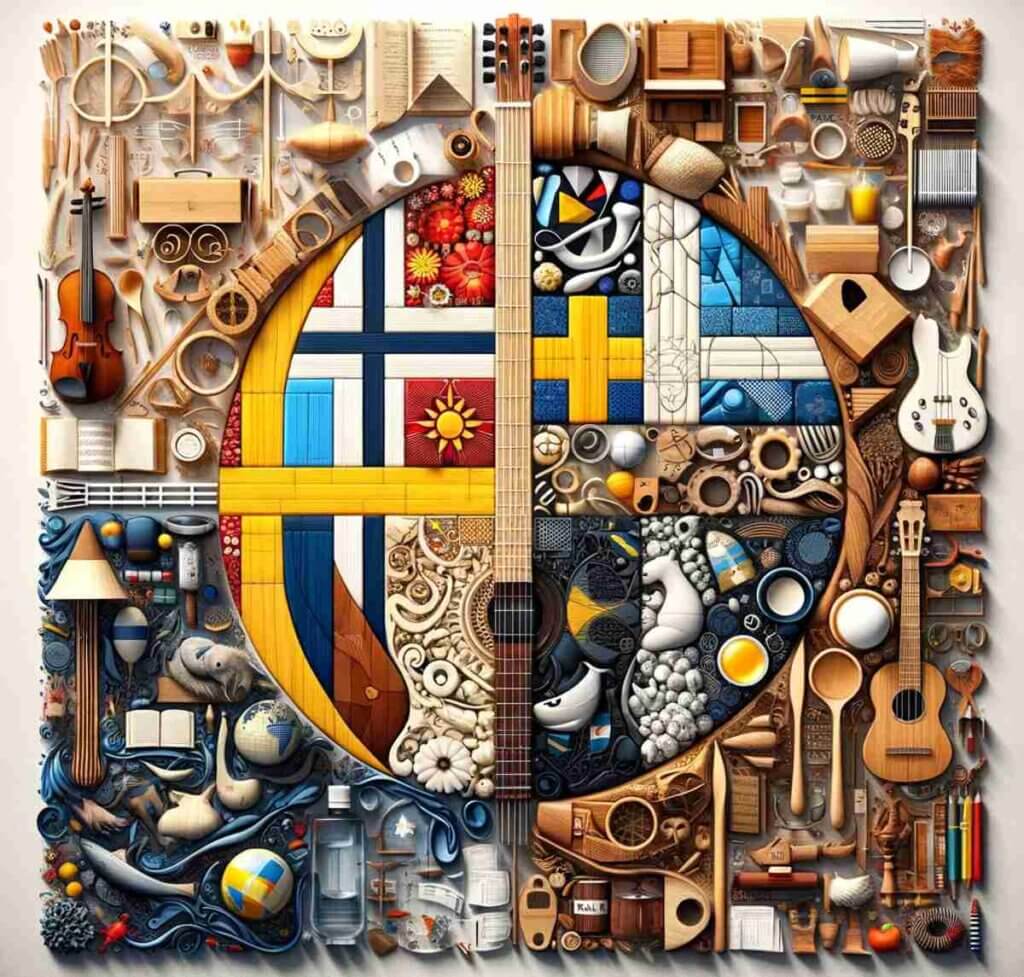
Nordic interior design, though united by common principles of simplicity, functionality, and a deep connection with nature, exhibits a fascinating diversity as it flows through the different countries of the North. Each nation infuses its unique character, history, and landscape into its design ethos, creating a rich tapestry of styles that are distinct yet harmoniously interconnected.
Norwegian Design: Rustic Elegance Meets Modern Living
Norwegian interior design beautifully marries rustic elements with modern sensibilities. Inspired by Norway’s rugged landscapes – from mountain ranges to coastal fjords – this style incorporates natural, raw materials like wood and stone. Norwegian homes often feature large windows framing the stunning views, with interiors that resonate with the colors and textures of the outside world. It’s a style that speaks of a profound connection with nature, where tradition and modernity coexist in harmony.
Danish Design: Playfulness Meets Avant-Garde
Danish design stands out with its playful spirit and avant-garde approach. It’s where classic functionality meets whimsical creativity. Danish interiors often feature bold, sculptural furniture, innovative use of materials, and an eclectic mix of textures and colors. This design style reflects the Danish love for life – ‘hygge’ in its purest form – creating spaces that are not just beautiful but also filled with joy and personality.
Swedish Interiors: The Epitome of Streamlined Functionality
In Sweden, the design philosophy leans towards a more streamlined and functional aesthetic. Swedish interiors are a testament to the art of minimalism – clean lines, a monochromatic color palette, and an uncluttered space that breathes calmness and order. This approach is deeply rooted in the Swedish lifestyle, where every object has a purpose, and beauty is found in simplicity and efficiency.
Finnish Design: Innovation in Form and Material
Finnish design is renowned for its innovative use of form and material. It pushes the boundaries of traditional design, experimenting with new shapes, textures, and materials. Finnish interiors often showcase a blend of organic forms inspired by nature and cutting-edge design, reflecting Finland’s reputation for technological innovation. This approach results in spaces that are not just visually striking but also tactile and engaging, a reflection of the Finnish spirit of experimentation and discovery.
Each Nordic country contributes its unique voice to the chorus of Nordic design, creating a mosaic of aesthetics that is as varied as it is unified. From the playful creativity of Denmark to the streamlined functionality of Sweden, the rustic elegance of Norway, and the innovative spirit of Finland, the essence of Nordic design is a celebration of diversity, bound together by a shared love for simplicity, functionality, and beauty. It’s a testament to the rich cultural heritage and the vibrant contemporary spirit that animates the Nordic way of life.
Summary: Nordic Interior Design
Nordic interior design offers more than just a style; it provides a way of living – one that emphasizes simplicity, functionality, and a connection with nature. Whether it’s the serene simplicity of a Swedish living room, the playful elegance of a Danish lounge, or the rustic charm of a Norwegian cabin, these designs invite tranquility, light, and harmony into our homes. Embracing Nordic design principles can transform spaces into sanctuaries of calm and beauty, reflecting the serene essence of the North.
I think I have touched on every aspect of Nordic interior design for you to understand the real inspiration, harmony, and logic behind it. Kudos to our designers for the amazing illustrations. I hope you had fun reading it; if yes, don’t forget to subscribe to Fika Monthly to get the latest Nordic design articles directly to your inbox.








